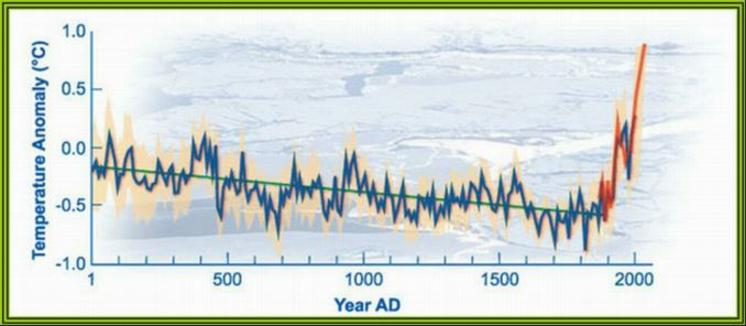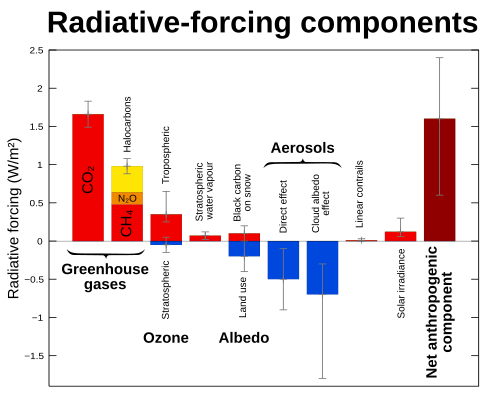I have been asked several times recently "Is all the Warming from CO2?" "What caused past warm events?"
Maybe this will help....
Most of what I’m posting comes from the IPCC #4.
You can see it's not just a matter of CO2, it's actually quite complicated...
Let's start with the scientific term:. The various influences are called Radiative Forcing: That is, all heating (or cooling) of the Earth as a whole is done through various forms of radiation which force temperatures to rise and fall. (Except for Geothermal heat, which is 1/10,000 of that of the Sun, and is relatively constant.)
If you wish to know more, read This: http://en.wikipedia.org/wiki/Geothermal_(geology)
The second thing to know is that the Forcings can be divided into two types: Long Term and Short Term.
The third complication is that some Forcings are negative – that is, they actually cool the Earth, not warm it. A simple pie chart won’t take that into account.
There is also a third source of heat, Feedbacks. These are actually the most dangerous, but only come as a reaction to the increase (or decrease) of heat. So we’ll park those.
Long Term Forcings: These are very powerful, able to raise the temps by 30- 40*C, but they slow acting, in the order of tens of thousands, or even millions of years.. So they just cannot be the source of our present warming.
Solar Forcing due to gradual increase in Sun’s output – The sun has been gradually warming over its entire lifetime. This is why you hear deniers say “500 Million years ago, CO2 was much higher than today, and yet it was cooler/the same temp as now. That proves CO2 is not a warming agent”. Actually, it proves exactly the opposite. If it wasn’t for the CO2, the Earth would have been frozen solid.
Forcing due to continental drift can completely change the climate – when all the continents come together, especially near the Equator, the land in the centre heats dramatically, and as it’s a long way from water, the atmosphere becomes very hot & dry.
Solar Forcing due to orbital changes. There are several of these, such as the Milankovitch Cycles. These are responsible for the ice ages. We are in a cooling phase of these cycles, and if all else were equal, we’d be in an ice age in about 20,000 years.
Short Term Forcings: These are the ones that really affect our lives in a time span that humans can notice in their lifetimes, and the ones used to create the chart above.
Solar forcing is the energy the sun sends to Earth, warming the atmosphere, and it does vary. This does affect our climate, but no more than 0.3*C in recent times.
Natural greenhouse gases: The two main gases of interest are carbon dioxide and methane. Many natural events affect these gases, but natural fluctuations are usually of regional scale and don't perturb the world average much.
Volcanic eruptions put sulfate aerosols into the atmosphere, cooling the surface and warming the upper atmosphere. The largest eruptions can affect the entire planet; for instance the 1991 eruption of Pinatubo cooled global average temperature by nearly a degree the following year. But Volcanic cooling effects are very short term, so while they can certainly change Global temps, the effects are for only a year or two. As for the warming from CO2, the smaller eruptions that go on all the time are not significant – for instance, Humans put out 150 times more CO2 per year than all the volcanoes combined.
http://answers.yahoo.com/question/index?qid=20070326103910AAvYl7f
Ocean Circulation has a large effect on Climate, as evidenced by the El Nino / La Nina cycle that goes on every few years, moving temps about 3*C in areas on the west coast of North America, and by the Gulf Stream, which normally raise temps in Europe by as much as 10*C. Both of these currents work by circulating water from ocean depths & warming/cooling the surrounding land. But as these two examples show, their effects are limited, both in area and in total temperature differences.
Ozone is a naturally occurring greenhouse gas. Interestingly, in the 1970’s, all the CFC’s we were pouring into the air were breaking down the Ozone, which was cooling the earth slightly (part of the reason some scientists at the time thought we were heading for Global Cooling . When we cleaned up the CFC ‘s because of all the bad effects of lowering Ozone, we then returned the earlier warming – fix one problem, create another….
Human Forcings
The oldest human forcing is changing land use that affects how the soil absorbs sunlight. For thousands of years, human activities have reduced forests, drained wetlands, dammed watercourses and disturbed the soil. The history of this factor is very poorly known, but it is growing in significance as human population and industry grow. One estimate is that recent land-use changes have acted to cool the northern hemisphere slightly as a whole.
CO2 produced by burning fossil fuels is the biggest single forcing. And its effects last for thousands of years.
Methane from rotting material and Farming is also a significant factor. Methods have been found to reduce it without seriously increasing costs or labour, but farmers are conservative by nature.
Aerosols are all the smoke, smog, and other junk that we (and Volcanoes) pour into the air, which blocks the Sun and cools the Earth. In the 1970’s, we were producing huge amounts of the stuff, and this was another reason some scientists thought we were in for Global Cooling. But of course, like the Ozone problem, because of health issues we cleaned it up, and now we have more warming. (In fact, the CO2 was always going to overwhelm it anyway, but there’s no doubt that reducing pollution sped up the Warming.)
Black Carbon is an interesting forcing – if it lands on snow, it adds to warming, as it prevents the snow from reflecting the Sunlight. But if it hits land, it’s actually more reflective than most plants and dirt, so it actually cools things… http://www.unisci.com/stories/20013/0817013.htm
Linear Contrails – These are the clouds created by jet aircraft, which have an overall slight warming effect.
Feedbacks: These are the effects which scare scientists the most. I didn't include them until now because they don't come into play until the planet is already warmed by the other sources I listed. But that doesn't make them any less important - in fact, it's exactly the opposite.
The first feedback to consider is Ice and Snow melt, which then leaves darker surfaces over much of the Earth, particularly the Arctic. Those increases in heat absorption, particularly in the Arctic, are one of the most worriesome features, and one reason that area is warming much faster than most of the rest of the globe. And of course, the warmer it gets, the more this melting and warming accelerates..
The other major feedback is water vapour, which is a very powerful Greenhouse gas. It wasn't included in the document because it only stays in the air about 24 hours on average, so by itself it does not have much effect on climate. But when the air is already warm, more water vapour evaporates into the air, which then adds to the warming even more, which brings in more water vapour, etc.
The other really nasty item is the amount of methane frozen in the Arctic and in the bottom of the ocean. Methane is 22x stronger than CO2, and if that starts to melt in large quantities, (it's already melting ahead of schedule) nobody's too sure just how warm things will get. So far, the models don't fully account for that, because the scientists are wary of being called "alarmists".
Welcome to By 2100!
This Blog is designed to be a Diary of Events illustrating Global Climate Change, and where it will lead.
Commentary is encouraged, but this Blog is not intended for discussion on the Validity of Climate Change.
Category Labels
- Climate Events (85)
- Climate Solutions (45)
- Videos (42)
- Climate Statistics (39)
- The Deniers (34)
- Humour (15)
- Basic Information (5)
Sunday, January 16, 2011
Subscribe to:
Post Comments (Atom)
www.know-the-number.com
Our Climate is Changing!Please download Flash Player.


No comments:
Post a Comment